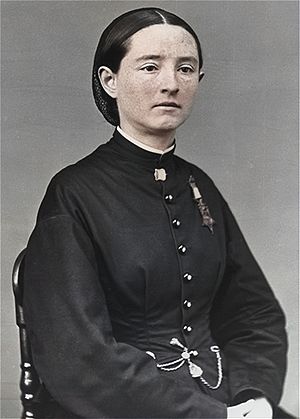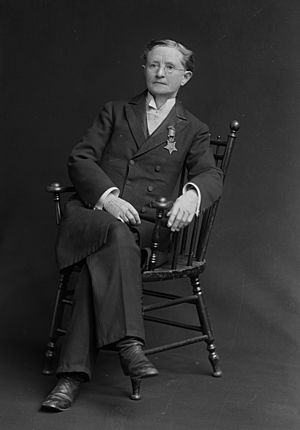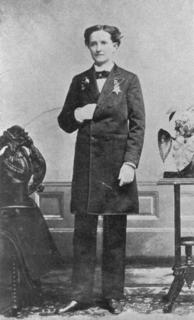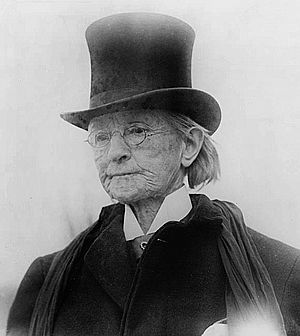Mary Edwards Walker facts for kids
Quick facts for kids
Mary Edwards Walker
|
|
|---|---|

Walker with her Medal of Honor
|
|
| Born | November 26, 1832 |
| Died | February 21, 1919 (aged 86) Oswego, New York, U.S.
|
| Resting place | Rural cemetery, Oswego |
| Education | Falley Seminary (1850–1852) Syracuse Medical College (1853–1855) Hygeio-Therapeutic College (1862) |
| Occupation | Surgeon |
| Employer | United States Army |
| Known for | Receiving the Medal of Honor during the American Civil War, was the first female U.S. Army surgeon, prohibitionist, abolitionist, first and only female Medal of Honor recipient |
| Spouse(s) | Albert Miller |
| Awards | Medal of Honor |
Mary Edwards Walker (born November 26, 1832 – died February 21, 1919) was an amazing American doctor and activist. She fought against slavery, supported the ban on alcohol, and was a prisoner of war. She is the only woman ever to receive the Medal of Honor, which is the highest military award in the United States.
In 1855, she became a medical doctor. She volunteered to help the Union Army during the American Civil War. Even though women were not usually allowed to be army doctors, she served as a surgeon. She was even captured by Confederate soldiers and held as a spy.
After the war, she received the Medal of Honor for her brave work treating wounded soldiers. Her name was removed from the list of Medal of Honor recipients in 1917, but it was put back in 1977. Mary Walker also spent her life speaking out for women's right to vote. She continued this work until she passed away in 1919.
Contents
Early Life and Education
Mary Edwards Walker was born in Oswego, New York, on November 26, 1832. She was the youngest of seven children. Her parents, Alvah and Vesta Walker, were very open-minded for their time. They taught all their children, including their daughters, to be independent and to stand up for what was right.
Her parents believed that girls should be as educated as boys. So, they started the first free schoolhouse in Oswego. After finishing primary school, Mary went to Falley Seminary. This school taught about new ideas in gender roles, education, and health. Mary also loved to read her father's medical books. This sparked her early interest in medicine.
She later taught at a school to earn money for college. Mary then went to Syracuse Medical College. She graduated with honors in 1855, becoming a medical doctor. She was the only woman in her class.
Mary married a fellow medical student, Albert Miller, in 1855. She wore a short skirt with trousers and refused to say "obey" in her vows. She also kept her own last name. They opened a medical practice together, but it was hard for them. People at that time often did not trust or respect female doctors. They later divorced.
In 1860, Mary briefly attended Bowen Collegiate Institute. She was suspended because she insisted on joining the school's debating society, which had only been for men before she joined.
Dress Reform
Mary Walker believed that traditional women's clothing was unhealthy and restrictive. She often said that women suffered because of their "unhygienic manner of dressing!" She disliked long skirts and many petticoats. She felt they were uncomfortable, made it hard to move, and collected dirt.
From a young age, she tried different skirt lengths and layers. She always wore men's trousers underneath. By 1861, she usually wore trousers under a knee-length dress. Her family supported her clothing choices. However, many people criticized her. Once, she was even attacked with eggs for her clothing.
Despite the criticism, Mary kept fighting for dress reform. She believed women's clothes should "protect the person, and allow freedom of motion." She wrote about how women's fashion harmed health and cost too much. Her ideas made her popular among other feminists and female doctors.
In 1870, Mary was arrested in New Orleans for dressing like a man. She was released when the police recognized her. She famously said, "I don't wear men's clothes, I wear my own clothes."
American Civil War Service
When the American Civil War began, Mary Walker volunteered as a surgeon. The Army first turned her down because she was a woman. They offered her a nursing job, but she wanted to be a surgeon. So, she volunteered as a civilian surgeon for the Union Army.
At first, she could only work as a nurse. She served at the First Battle of Bull Run in 1861. She also worked at a hospital in Washington, D.C. She was an unpaid field surgeon near the front lines. She helped at the Battle of Fredericksburg and after the Battle of Chickamauga. Mary wore men's clothing during her work. She said it made it easier to do her demanding job.
In September 1863, the U.S. Army officially hired her as a "Contract Acting Assistant Surgeon." This made her the first female surgeon employed by the U.S. Army. She was later appointed assistant surgeon for the 52nd Ohio Infantry. She often crossed battle lines to treat civilians.
On April 10, 1864, Confederate troops captured her. They arrested her as a spy. She had just helped a Confederate doctor perform surgery. She was sent to Castle Thunder prison in Richmond, Virginia. She stayed there until August 12, 1864. She was released as part of a prisoner exchange for a Confederate surgeon. While in prison, she refused to wear the clothes they gave her.
After her release, she worked as a supervisor at a female prison in Kentucky. She also led an orphanage in Tennessee.
Later Life and Activism
After the war, Mary Walker received a disability pension. This was for muscle weakness she got while in prison. She received $8.50 a month, which later increased to $20.
She became a writer and speaker. She supported health care, the temperance movement, women's rights, and dress reform for women. She was often arrested for wearing men's clothing. She always insisted on her right to wear what she felt was proper. She wrote two books about women's rights and clothing.
Mary Walker was a member of the women's suffrage movement. She tried to register to vote in 1871 but was turned away. She believed women already had the right to vote under the Constitution. She thought Congress just needed to pass laws to make it happen. Other suffrage leaders later wanted a new constitutional amendment. This was different from her view. So, she became less popular with the movement. She still went to conventions and shared her ideas.
In 1907, she wrote "Crowning Constitutional Argument." In it, she argued that women already had the right to vote. She spoke about women's suffrage to committees in the U.S. House of Representatives in 1912 and 1914.
Mary Walker passed away on February 21, 1919, at age 86. She was buried in Oswego, New York. An American flag was draped over her coffin, and she wore a black suit. Her death came one year before the Nineteenth Amendment to the United States Constitution was passed. This amendment finally gave women the right to vote.
Honors and Awards
Medal of Honor
After the Civil War, Mary Walker wanted official recognition for her service. President Andrew Johnson personally awarded her the Medal of Honor. This was for her brave work treating the wounded during the war. She was not a commissioned officer, but she received the medal anyway.
In 1916, the U.S. Congress created a new law for Medal of Honor recipients. The Army then reviewed past awards. In 1917, Mary Walker's name was removed from the Medal of Honor list. This happened because she was a civilian contract surgeon, not a military officer. Over 900 other names were also removed at that time.
However, in 1977, Mary Walker's Medal of Honor was officially restored. She believed she received the medal because she went into enemy territory to help people who were suffering. No man had the courage to do so, she said, for fear of being imprisoned.
National Women's Hall of Fame
Mary Walker was honored by being inducted into the National Women's Hall of Fame in 2000.
Legacy
Many things have been named in honor of Mary Edwards Walker:
- During World War II, a ship called the SS Mary Walker was named after her.
- In 1982, the U.S. Postal Service issued a twenty-cent stamp in her honor.
- The medical facilities at SUNY Oswego are called the Mary Walker Health Center.
- There is a U.S. Army Reserve center named for her in Walker, Michigan.
- The Whitman-Walker Clinic in Washington, D.C., is named after her and the poet Walt Whitman.
- The Mary Walker Clinic at Fort Irwin National Training Center in California is named in her honor.
- The Mary E. Walker House in Philadelphia helps homeless women veterans.
- In 2012, a large bronze statue honoring Walker was unveiled in Oswego, New York.
- In 2019, she was included in Hillary and Chelsea Clinton's book The Book of Gutsy Women: Favorite Stories of Courage and Resilience.
Images for kids
See also
 In Spanish: Mary Edwards Walker para niños
In Spanish: Mary Edwards Walker para niños





